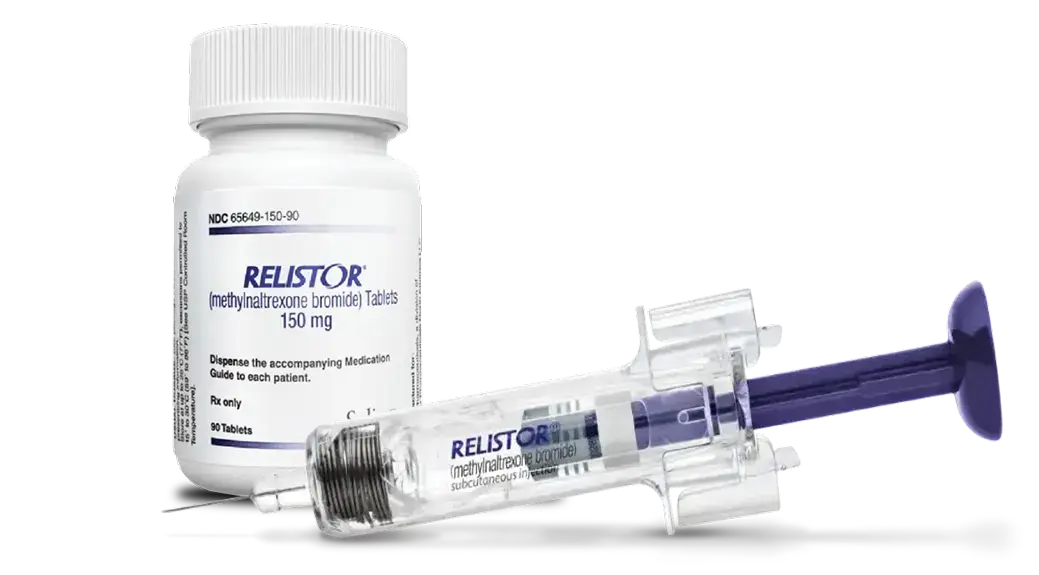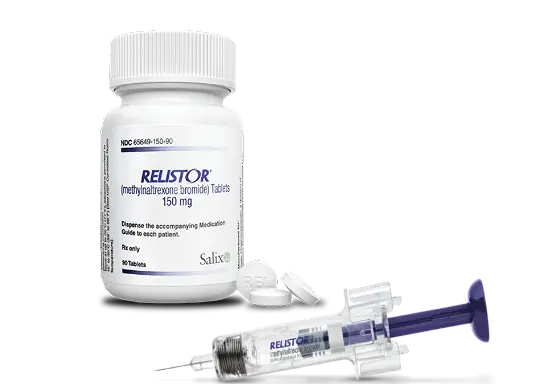Explore the mechanism of action of RELISTOR


RELISTOR molecular properties
RELISTOR
molecular properties
RELISTOR is a PAMORA that has a methylated structure1
- Restricted from crossing the blood-brain barrier*
- No impact on opioid-mediated analgesia in the central nervous system
*Patients having disruptions to the blood-brain barrier may be at increased risk for opioid withdrawal and/or reduced analgesia and should be monitored for adequacy of analgesia and symptoms of opioid withdrawal.1

RELISTOR is the only PAMORA not metabolized through the cytochrome P450 pathway (including CYP3A4)1,6,7
- RELISTOR does not have any significant interactions with any of the cytochrome (CYP) enzymes, so there are no pharmacokinetic drug-drug interactions1,6,7
- RELISTOR subcutaneous injection is minimally metabolized and is excreted from the body primarily unchanged1
 RELISTOR molecular properties
RELISTOR molecular properties
RELISTOR is a PAMORA that has
a methylated structure1
- Restricted from crossing the
blood-brain barrier* - No impact on opioid-mediated
analgesia in the central nervous system
*Patients having disruptions to the blood-brain barrier may be at increased risk for opioid withdrawal and/or reduced analgesia and should be monitored for adequacy of analgesia and symptoms of opioid withdrawal.1
RELISTOR is the only PAMORA not metabolized through the cytochrome P450 pathway (including CYP3A4)1,6,7
- RELISTOR does not have any significant interactions with any of the cytochrome (CYP) enzymes, so there are no pharmacokinetic drug-drug interactions1,6,7
- RELISTOR subcutaneous injection is minimally metabolized and is excreted from the body primarily unchanged1
The first and only injectable PAMORA and the only PAMORA indicated to treat OIC related to advanced illness or pain caused by active cancer for patients who require opioid dosage escalation for palliative care1,6-8
REFERENCES: 1. RELISTOR [prescribing information]. Bridgewater, NJ: Salix Pharmaceuticals. 2. Streicher JM, Bilsky EJ. Peripherally acting μ-opioid receptor antagonists for the treatment of opioid-related side effects: mechanism of action and clinical implications. J Pharm Pract. 2018;31(6):658-669. 3. Bader S, Jaroslawski K, Blum HE, Becker G. Opioid-induced constipation in advanced illness: safety and efficacy of methylnaltrexone bromide. Clin Med Insights Oncol. 2011;5:201-211. 4. Yuan CS, Foss JF, Osinski J, Toledano A, Roizen MF, Moss J. The safety and efficacy of oral methylnaltrexone in preventing morphine-induced delay in oral-cecal transit time. Clin Pharmacol Ther. 1997;61(4):467-475. 5. Yuan CS, Wei G, Foss JF, O’Connor M, Karrison T, Osinski J. Effects of subcutaneous methylnaltrexone on morphine-induced peripherally mediated side effects: a double-blind randomized placebo-controlled trial. J Pharmacol Exp Ther. 2002;300(1):118-123. 6. Symproic. Prescribing information. BioDelivery Sciences International; 2020. 7. Movantik. Prescribing information. RedHill Biopharma Ltd; 2023. 8. Pergolizzi JV Jr, Christo PJ, LeQuang JA, Magnusson P. The use of peripheral μ-opioid receptor antagonists (PAMORA) in the management of opioid-induced constipation: an update on their efficacy and safety. Drug Des Devel Ther. 2020;14:1009-1025.